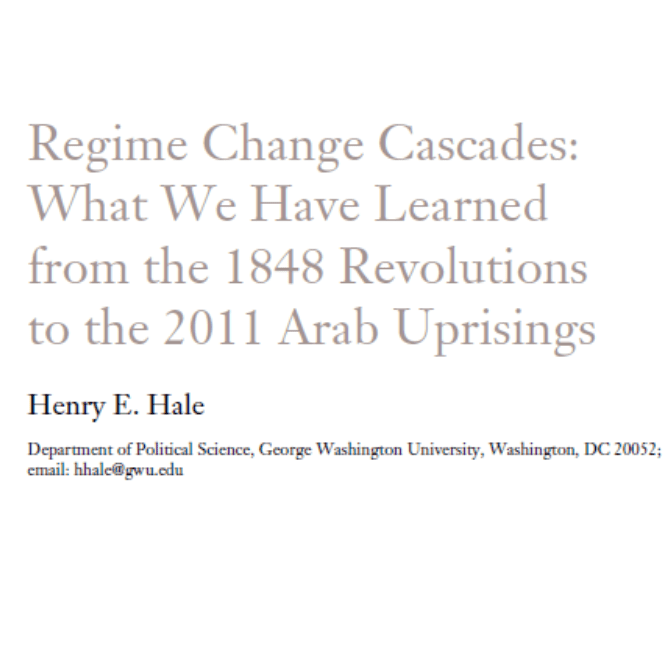(Journal Article)
Abstract: Works on the 1848 revolutions, 1989 collapse of European communism, 1998–2005 postcommunist color revolutions, and 2011 Arab uprisings frequently cross-reference each other, implying what is called here the concept of a “regime change cascade.” Research on these “Big Four” events shows that cascading can occur in protest calling for regime change as well as revolution in the name of regime change, but these rarely lead to actual regime change. Regime change cascades can occur through demonstration effects and active mediation, although common external causes and contemporaneous domestic triggers can cause events outwardly resembling them. Regime change cascades tend to occur where (a) there exists a common frame of political reference, (b) unpopular leaderships are becoming lame ducks; (c) elites lack other focal points for coordinated defection, and (d) structural conditions supporting a new regime type are in place. Cascading to hybrid regimes or autocracy may be more likely than cascading to democracy.
Introduction: The notion of regime change cascades is one of the most exciting in world politics. Tremendous euphoria filled observer accounts of the revolutions that ripped through Europe in 1848, the rapid collapse of successive communist regimes in 1989, the “color revolutions” that toppled one post-Soviet autocrat after another in the 2000s, and the “Arab Spring” that set a series of Middle Eastern regimes alight in 2011. In each case, observers imagined mass uprisings spreading rapidly across national boundaries to replace dictator after dictator with new leaders proclaiming a dawning era of democracy and freedom. The notion also has a dark side: this is the dreaded “domino theory,” the understanding that some regime change ushers in repression rather than democracy and the fear that one authoritarian coup will trigger others. The communist takeovers that occurred just after World War II thus inspired panic that ever more regimes in Asia, Latin America, and beyond would succumb to the Marxist-Leninist menace, and Iran's 1979 revolution ignited fears in many Western circles that a cascade of theocratic regime change could sweep the Middle East.
Such ideas can have major policy implications. Some justified the 2003 American invasion of Iraq with the prospect of sparking a democratizing wave in the Middle East, and the 2011 Arab uprisings eventually led NATO to directly intervene in Libya, prompting a serious debate about whether to do the same in Syria. Russia's nondemocratic leadership is widely believed to be arming the Syrian regime (which is massacring its own people) for fear that its easy fall could inspire antiauthoritarians everywhere, including in Russia itself. The fear of a communist regime cascade infamously led the United States to embark on its Vietnam military debacle and to sacrifice its own democratic principles by propping up brutal but anticommunist dictators in Latin America—and even to help overthrow an elected leftist leadership in Chile. The prospect of rapid, often unexpected regime change in multiple countries at about the same time can also pose major challenges for policy makers who have built longstanding and important relationships with the challenged leaders.
It would seem crucial, then, for us to come to a solid understanding of regime change cascades. Fortunately, a growing body of social science research helps us do just that, although such work has focused far more on events linked to democratization than to possible cascading change to other regime types. The pages that follow examine some of the cumulative findings, highlighting some dangers inherent to such research, showing how existing work can help provide a framework for future research, and offering some tentative general conclusions that might assist in advancing the debate. In particular, this article argues for the importance of clearly distinguishing three phenomena that are often conflated at the outset of such compelling events: cascades of protest aimed at regime change; revolution in the name of regime change; and actual regime change itself. It also highlights different mechanisms by which protest, revolution, and regime change might cascade, but also a number of factors that can mislead scholars and observers by causing the appearance of cascading in the absence of an actual cascade. Research into four series of events commonly cross-referenced in the literature—the 1848 European revolutions, the 1989 fall of European communism, the postcommunist “color revolutions,” and the 2011 Arab uprisings—suggests that although protest cascades in the name of democracy are a widespread phenomenon, transnational cascading dynamics were less likely to be decisive in causing a revolution and quite unlikely to bring about actual regime change in a democratizing direction. In fact, research finds that many series of events that have been widely thought of as regime change cascades turn out not to be. This is because situations most propitious for their occurrence tend to be quite rare, including regimes out of synch with important underlying conditions and the presence of certain coordination problems facing elites within such regimes. There is some indication that cascades to authoritarianism or to hybrid regimes might not be quite as rare as cascading democratization.
Abstract | Table of Contents | Full Text (subscription may be required)
"Regime Change Cascades: What We Have Learned from the 1848 Revolutions to the 2011 Arab Uprisings"
© Annual Review of Political Science | Vol. 16: 331-353 | May 2013
First published online as a Review in Advance on February 28, 2013









